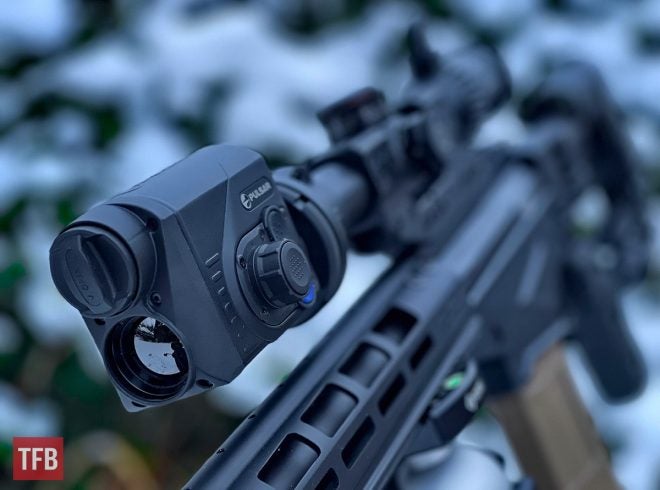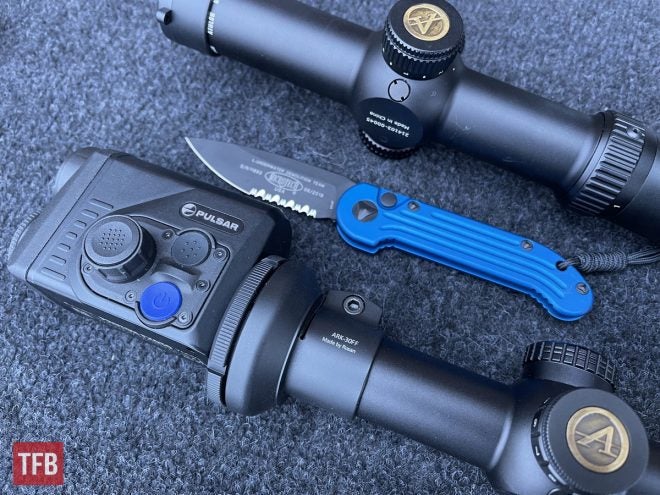The Pulsar Proton FXQ30 is a thermal imaging, clip-on front attachment for the riflescope(s) that you already own. With an adapter you mount it to the end of your daytime scope, then the system is ready to deliver you a thermal image. You use the reticle of your daytime scope, no additional zeroing should be needed, at least that’s my experience.
Pulsar NV @ TFB:
- 2022 – New Pulsar Thermion 2 XP50 LRF Pro Riflescope
- 2022 – Pulsar Talion XQ38 – Versatile Thermal Imaging Riflescope
- Pulsar KRYPTON FXG50 – The Ultimate Thermal Vision Front Attachment?
- Schmidt & Bender 5-45×56 PMII with Pulsar Krypton FXG50 Thermal Clip-On
Below: Ruger with Schmidt & Bender 3-21×50 EXOS, with the new LRH-MOA (SFP) reticle developed for long-range hunting. Spuhr hunting line mount and Aimpoint Acro red dot. Proton with adapter at the front.
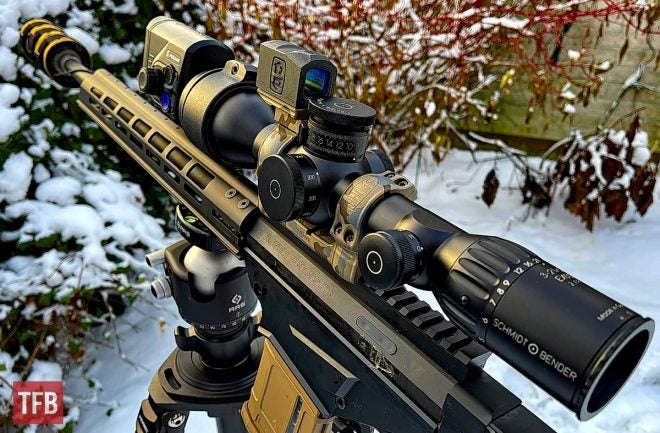
Overview
The first thing that strikes me is how small and light the unit is, and overall the build quality is excellent with IPХ7 protection for water and dust. The body is made out of magnesium alloy and the buttons are rubberized.
The heart of the Pulsar Proton FXQ30 is a 384×288 pixels @ 17 µm thermal sensor with a NETD of <40 mK (lower NETD is better). The objective lens is F30/1.2 with a fixed focus. It has a frame rate of 50 Hz, so there are no delays in the picture. The detection range is said to be 900 meters. All this is displayed on an AMOLED with 1024×768 pixels.

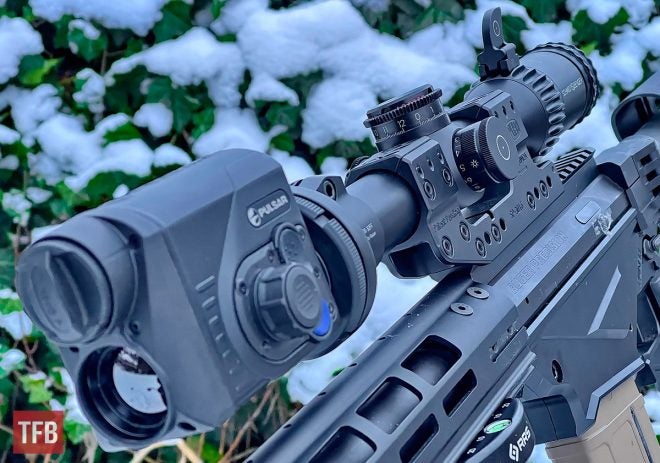
The controls are rubberized and have a nice feeling. Sometimes I over-travel with the scrolling wheel when I hit enter, which is a bit irritating but a minor thing really.
Image Quality
Perhaps the most important feature of any thermal, regardless of the technical specifications. You get the best result with a magnification on your daytime scope of about 1.5–4x. If you’re zooming in beyond that, you’re just enlarging and zooming into the pixels. There are 8 color palettes to choose from and for some reason, I liked red hot mostly on this unit. White hot was another favorite.
Below: Bird of prey at a wildlife park and two kids. Picture was taken with Proton (not attached to a firearm).
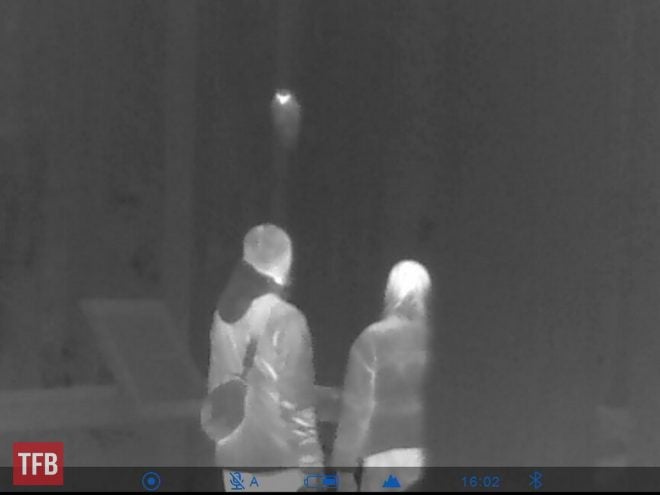
I have to admit that I’m spoiled by using mainly high-end, flagship thermal devices, and while this is a really good unit, it’s Pulsar’s entry-level clip-on. If the “taste buds” of your eyes are not spoilt like mine, I’m sure you would appreciate the image better. The Proton delivers but it does not have the power of more expensive models, which will show especially when there is moisture, fog and other unpleasant particles in the air.
You will still be able to hunt, but it is probably more geared towards hunting at a feeding station with known distances than varmint hunting at 200 yards and beyond. The fixed focus makes it easier to operate, but it also removes the option to focus and tweak to improve the details of your intended target. Optics are made up of compromises. What’s most important to you?
Below: Wolves at a wildlife park, distance probably around 45 meters. Picture taken with Proton, red hot (not attached to a firearm).
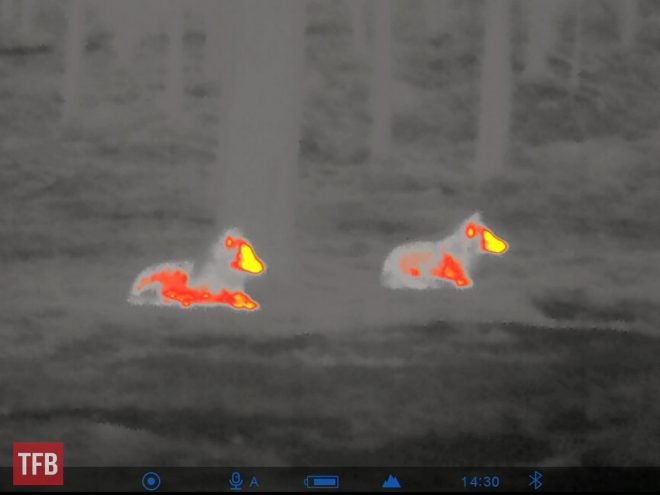
NOTE: You will see a few examples in this review with a long-range riflescope with a minimum power of 5x. It works, but please note this is not the intended use and I would not recommend it. Get the Krypton instead!
Below: Looking into the Proton FXQ30. Your daytime scope is looking on the display inside the Proton. The Proton does not have any crosshairs, you use your main riflescope’s reticle. I think this menu system is really good, and by scrolling the control wheel and hitting enter you change the settings. It’s fast and easy. No need to read the manual really, unless you want to go into depth.
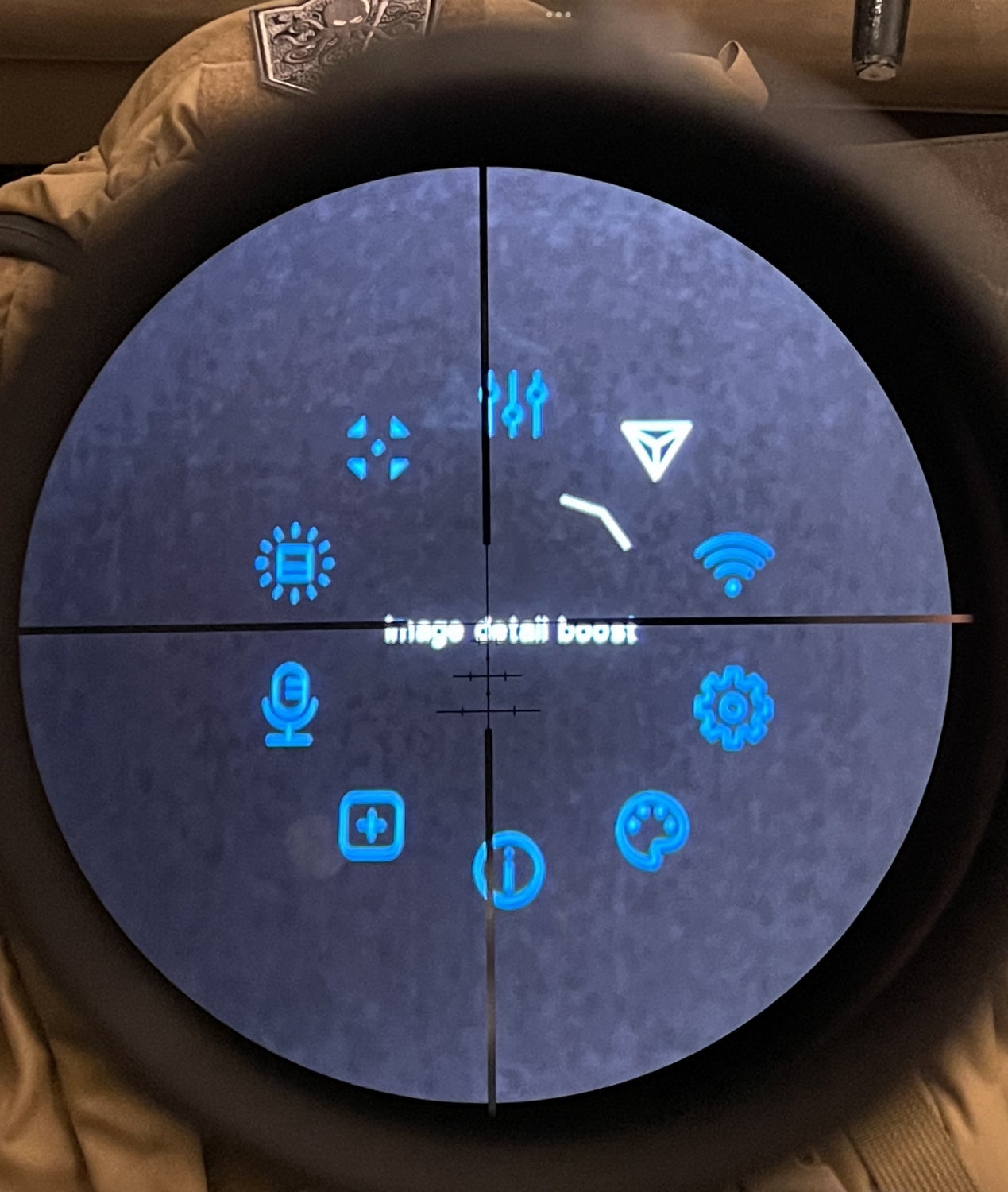
Adapters
To mount the Proton FXQ30 you use adapters made by Pulsar (for 42mm, 50mm or 56mm) for your daytime scope(s), and they all worked well. There’s a wide range of inserts so the adapter fits your scope.

The adapters can be found here. Rusan also makes Q-R one-piece adapters for the Pulsar Krypton where you can use 30 mm riflescopes (above). This means that you can use an LPVO (Low Power Variable Optic) together with a thermal, which I know a lot of our readers are looking for, and we’re going to show that in our reviews. The only issue I can see is that some rifles with very low mounts may have an issue if the adapter builds too much, so think before you buy and ask a dealer for help.
Below: Protonized! (I just invented that word) Schmidt & Bender 1-8x24mm PMII on a Ruger.

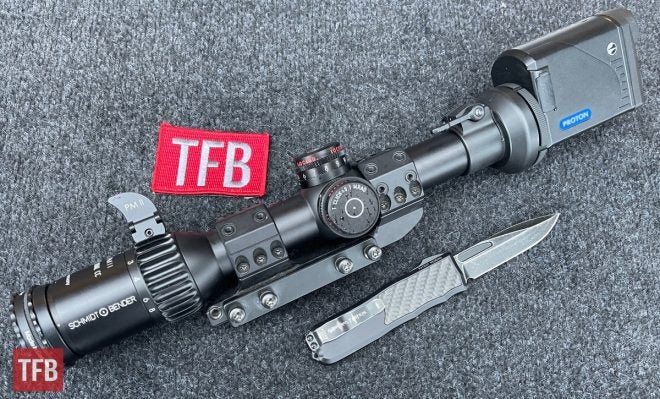
And here is what it looks like with the reticle on low power (looking into the ground, so no thermal signature really). Note again the Proton FXQ30 is “just” a 1x thermal device without crosshairs. You use the reticle on your daytime scope to aim. The Proton provides a thermal image of what’s in front of you.
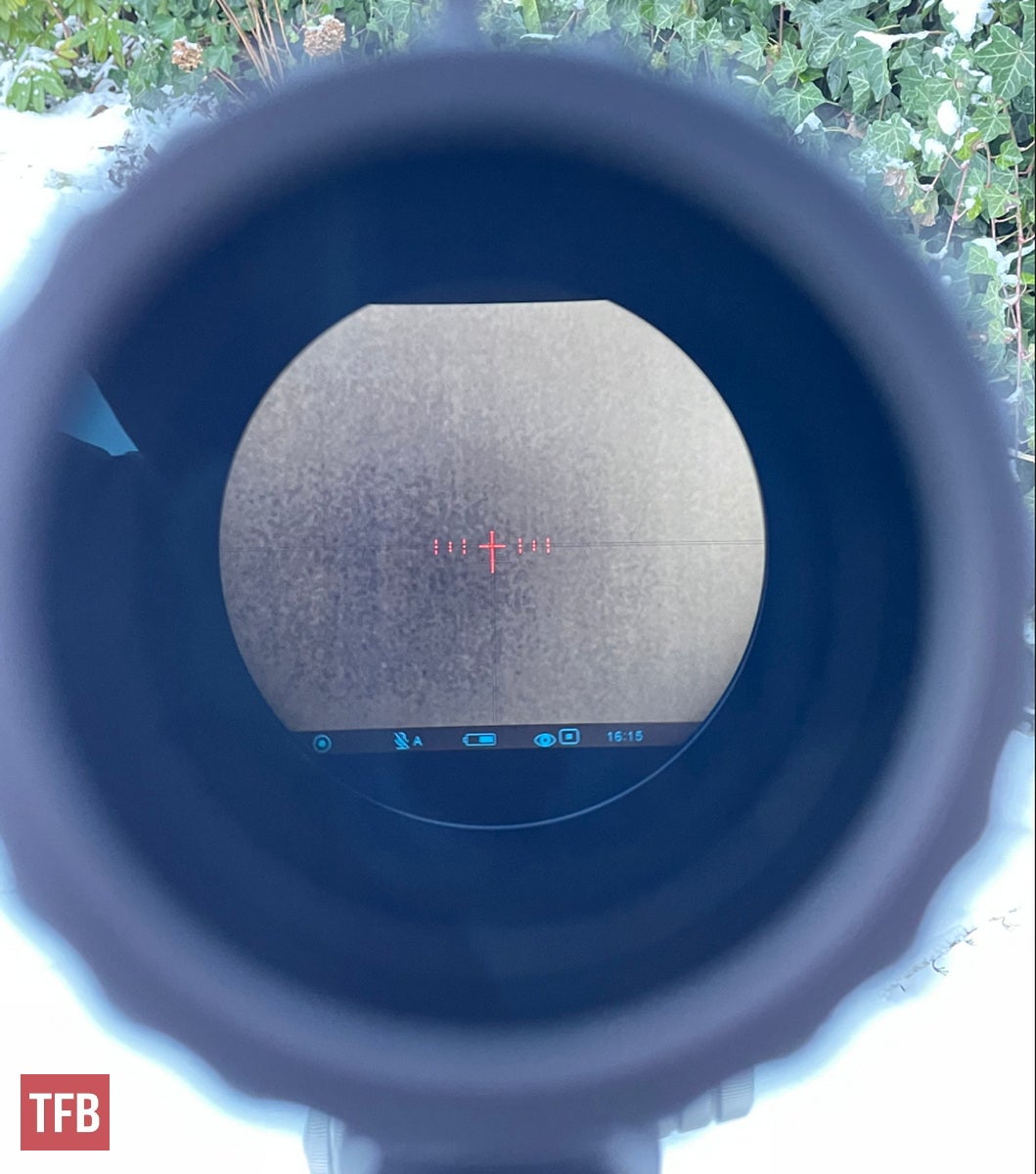
The unit is made in Lithuania.
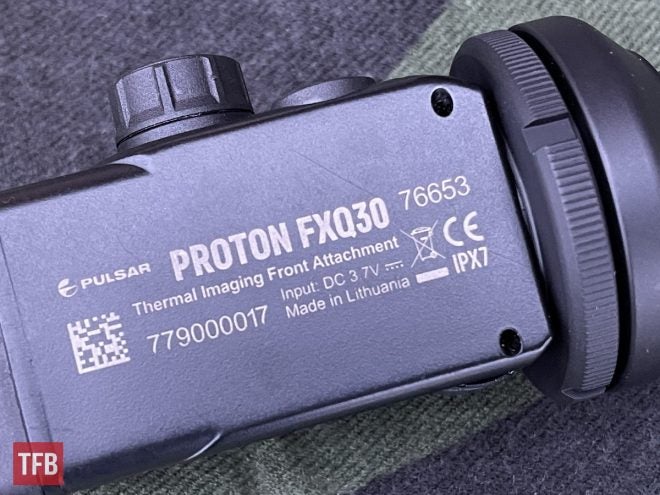
Below: A FN BAR Match in .308 Win. with a Swarovski Z8i 1-8×24. The Proton is recoil rated up to .375 H&H, 12-Gauge and 9.3×64. There’s an integrated photo and video recorder with 16 GB of internal memory. I record a lot but have never been even close to filling the memory. Pretty nice option here for those who hunt in the day and the night. Just remove the adapter and you’re set for the day again.
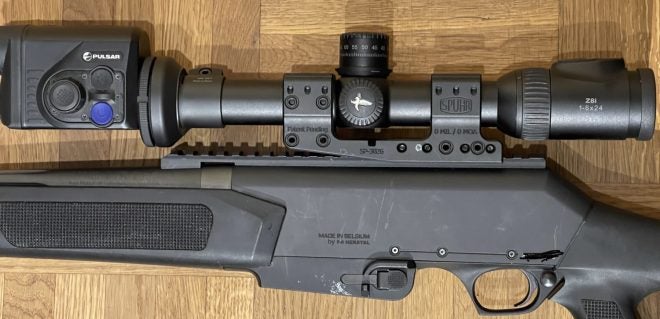
I have shot the Krypton, which works on the same principle as the Proton, out to 300 meters and a friend rang steel at 900 meters with his. If you get a good thermal image out to these distances I’m confident the Proton could do it as well.
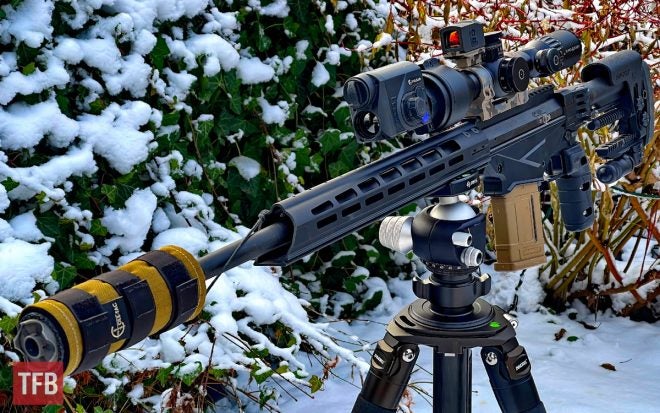
Below: These LPVOs from Athlon are up for a review during the spring. One has the Proton attached.
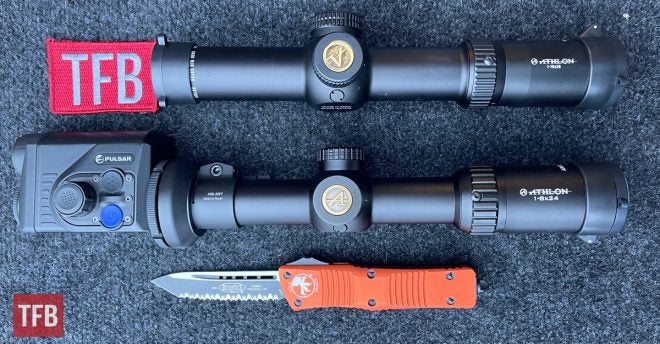
Video Samples
I’ve had the Proton for quite long, some of my videos are almost a year old now but they probably give you the best experience of what it will look like if you consider buying one. The conditions when I recorded the “Wild Boar Sow with Piglets” video below were quite horrible, -2 to -4C, light fog, pitch black outside, and a lot of trees in the way (again no firearm attached).
Check below for excellent proof that the Proton can deliver video even with really fast situations, as the roe deer discovers me at about 15 meters and decides to take off.
Pricing: The prices in Europe are as follows: Proton XQ30 is €2690 (including a monocular which we have not used) and Proton FXQ30 costs €2590 (tested here). Keep in mind that these are suggested prices and final prices are decided by the retailer, so they may differ from market to market.

Top view of the S&B 1.5-8x42mm S&B Stratos. This is also a sweet setup for hunting.

Below: I think this is a Golden Eagle hiding in the trees. Picture taken in a wildlife park, the device is not attached to a firearm. Birds generally give a very low thermal signature.
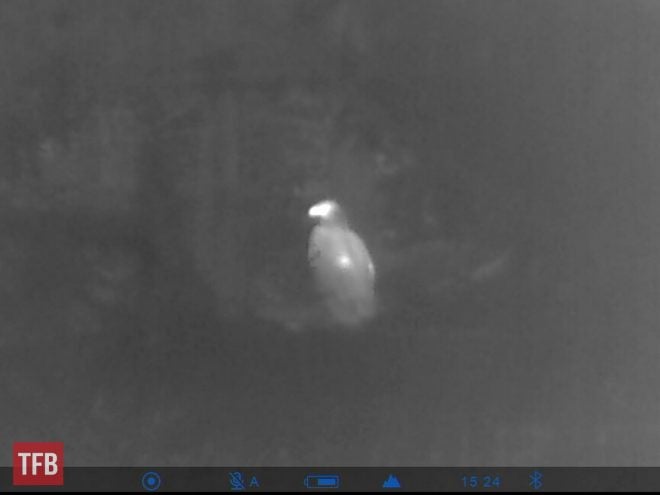
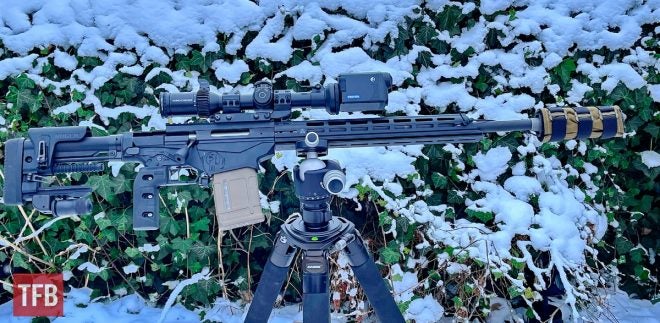
Below: Delta Hornet 1-6×24 mm with Proton. This could work as a good entry-level solution, with the Proton raising the total price quite drastically. A small Knipex tool as a reference.
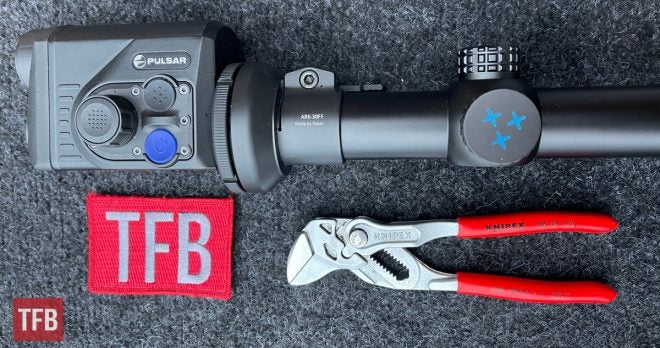
For those who like gadgets (and this one is very useful according to friends who have it), there is a Wireless Remote Control you can mount closer to the pistol grip.
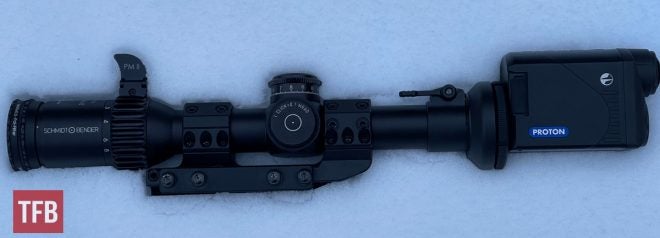

Below: Two completely different ways of seeing in the dark. The Pulsar Digex C50 Day-Night Vision riflescope with IR illumination or the Schmidt & Bender 1-8×24 PMII with a Rusan adapter and Proton Thermal (closest).
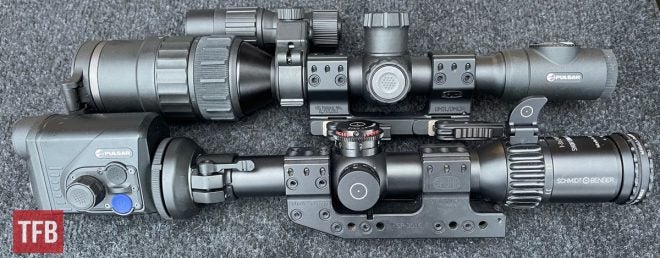
Powering up is done within seconds, which is quite an important factor. I encourage anyone in the market for any thermal to evaluate the time it takes to start up the unit.

Below: The Schmidt & Bender 1.5-8x42mm STRATOS Hunting Rifle Scope (review) in the Breitling Avenger 45 Night Mission Inspired Spuhr Mount. Cerakoting can be fun.

Below: Here’s what Proton’s bigger brother looks like, the Krypton. Mounted on a Delta Optical Javelin HD 4,5-30×56. This exact setup managed the 1,000 yards challenge, video here.
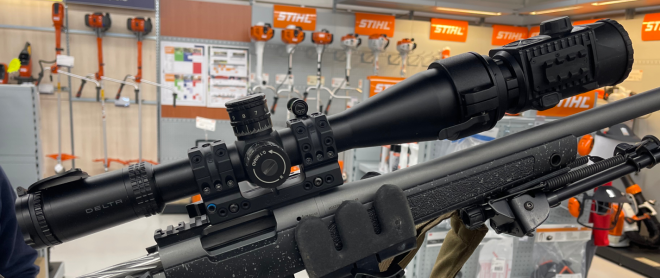
Below: Ruger Precision Rifle (ARCA rail modified) with B&T suppressor and Cole-Tac cover. The main daytime scope is Kahles’ new K525i DLR (Dynamic Long Range) in a Spuhr mount. Here you can see the thermal lens of the Proton and the replaceable battery above it. If you need more power while in the field, you can change the battery in less than a minute. Tripod from Innorel and head from Really Right Stuff.
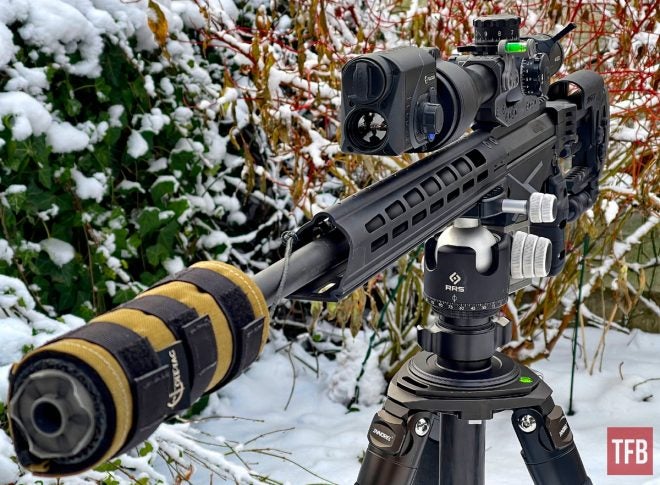
Below: Protonon a Swarovski Z6i (TFB’s LVPO reference sight) in a Spuhr hunting line mount (very slim and light). Benchmade SOCP dagger.
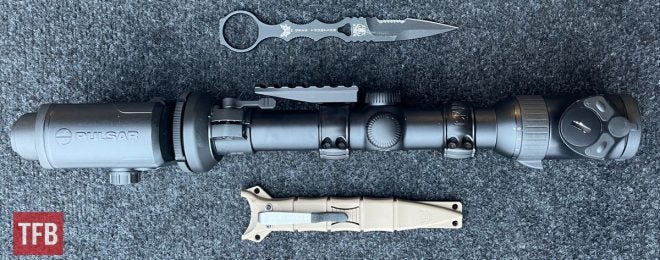
Swarovski Z6i 1-6x with Proton FXQ30. Distance 450 meters, if there is a heat source, you will see it. Winter, -6C, no direct sunlight. NOTE: Nothing here is mounted on a firearm, just for demonstration purposes.
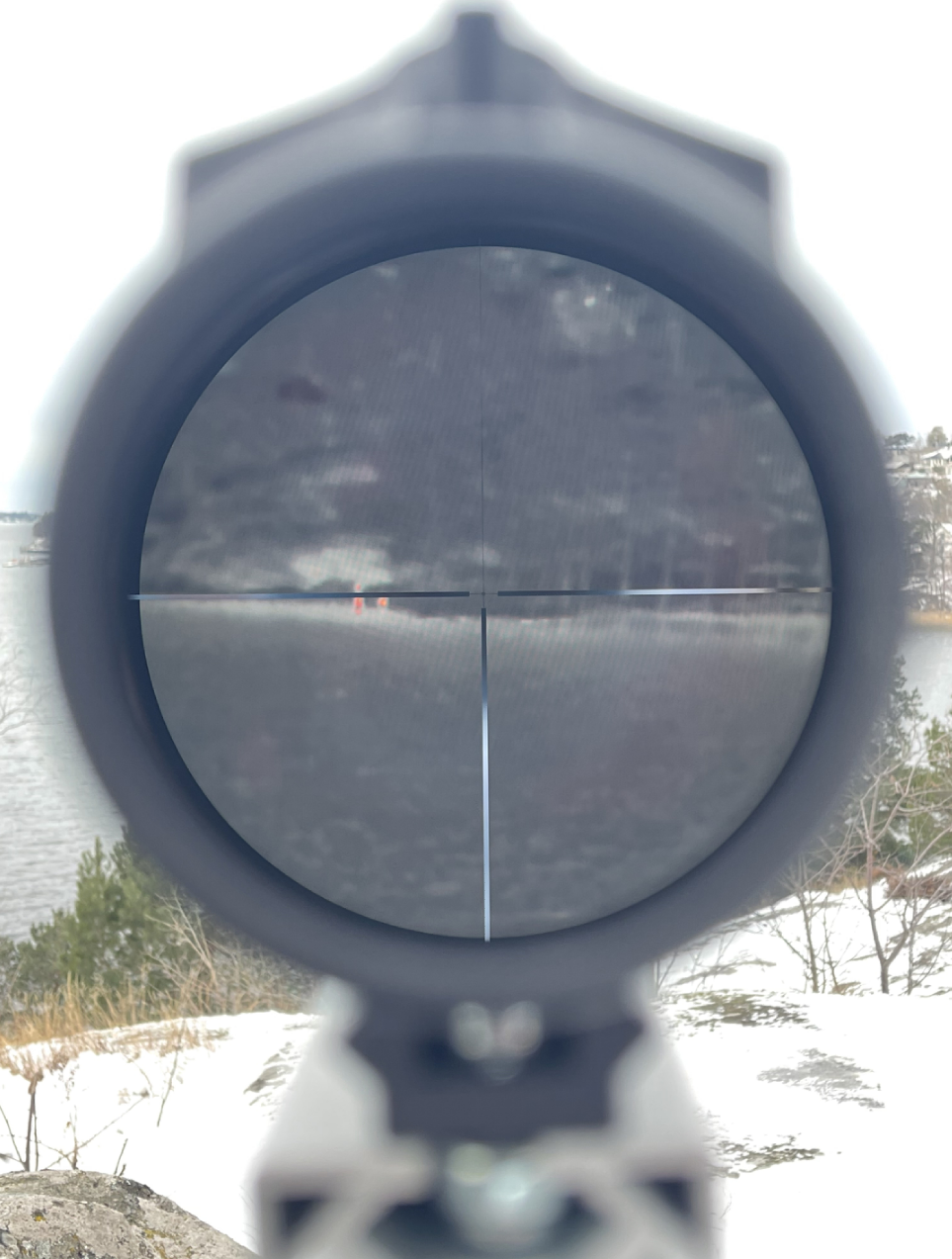
Picture taken through a Delta Hornet 1-6x24mm at about 1.5x with the Pulsar Proton FXQ30 attached.
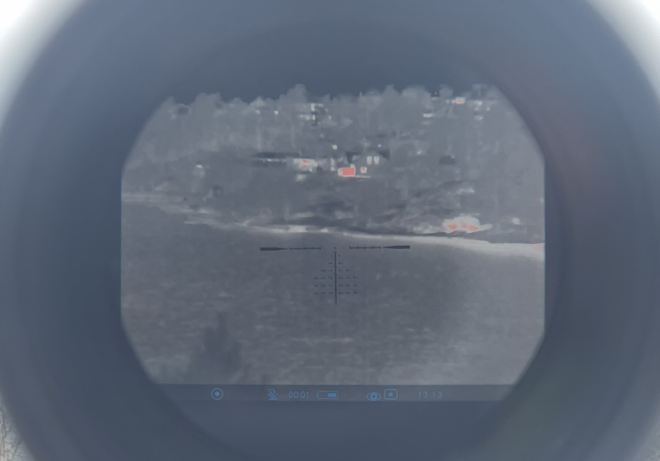
Below: The mounts are Spuhr SCP-3000 (Slim/Hunting line) and Spuhr SP-3002 (Hornet). Rusan 30 mm adapter.
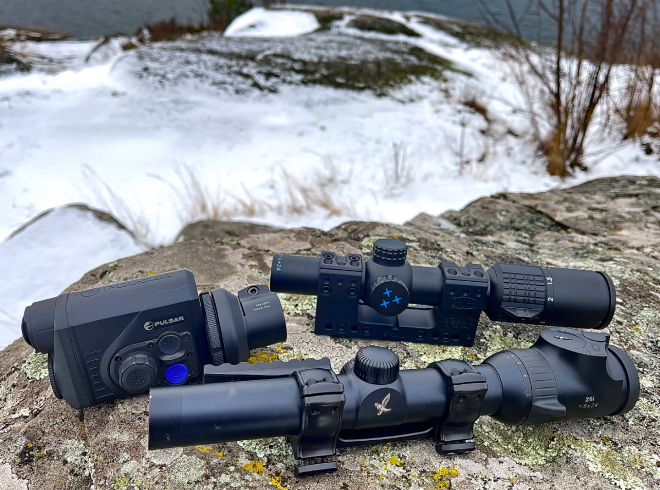
Conclusion
This is an entry- to mid-level thermal imaging front attachment and it does its job as advertised. The build quality and design are excellent and I had no issues with anything really. The internal software and external apps worked, which is not always the case with some of these devices. The Proton was also easy to use, and I think Pulsar now offers around 16 languages beyond English.
Bear in mind, I’ve had the Proton FXQ30 on a long-term review for almost a year, and I will soon hand the unit back to Pulsar. The adapter made by Rusan arrived last autumn from a friendly dealer, and it gave the opportunity to attach the Proton to 30 mm scopes – excellent! For me, it gives the Proton a new dimension, but it depends on the firearms and optics you’re using.
To check if there were any zeroing issues, I shot it several times with different riflescopes at 100 meters and I couldn’t really find any POI shifts to worry about. I used a small thermal pad as signature below. It isn’t big, but the Proton will detect and show at 100 meters and probably much further. Each square is 1×1 cm.
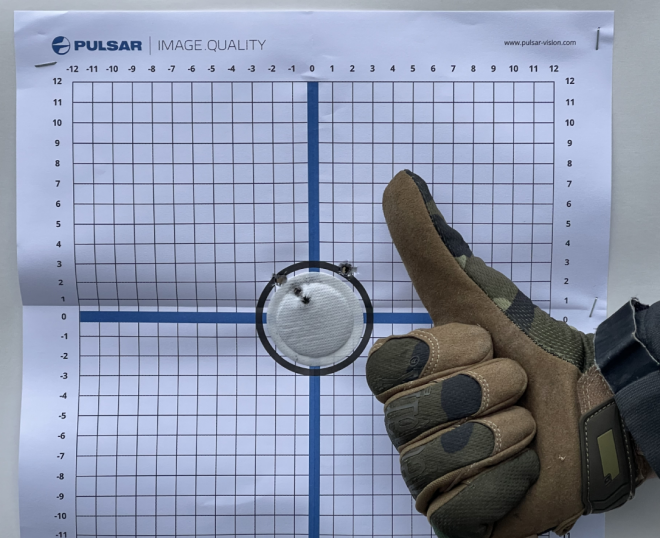
As I was writing up these last few words for this review, Pulsar released their Talion XQ38 Thermal Imaging Riflescope at SHOT Show. It’s pretty sweet to be able to transform your favorite hunting rifle to thermal capability within minutes, using the Proton. A few of my friends have started using thermal clip-ons for their wild boar hunting and they say they’re never going back to a dedicated thermal riflescope. However, looking at the price-point and potential performance of the new Talion that’s probably the way I personally would go today. To each his own, they are both good options.
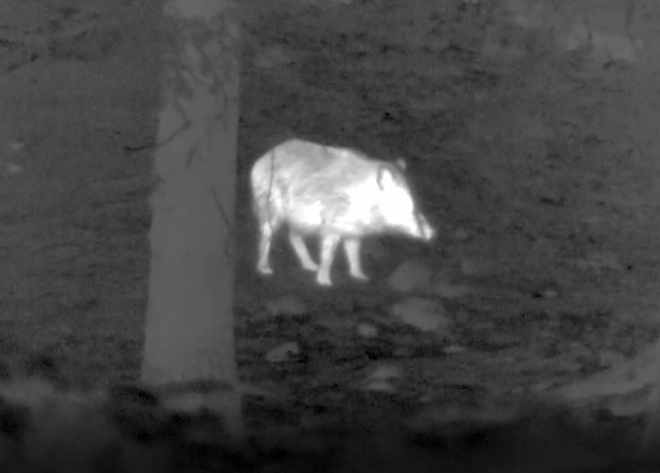
Protonized Wild Boar – Distance 40 meters guesstimated. Winter, -4C, light fog. Black hot worked well here as well, but you get more details in the target with white hot. If this was in the summer, the image quality would probably go from 3/10 to 7/10, with not much difference in temperature in the surroundings.
There are of course other brands and models, so before you buy, I suggest you find a dealer that lets you compare as many devices side-by-side as possible. The worse the weather the better. Also, make sure you chose a front attachment that doesn’t shift your POI. Good luck!
What do you think of the performance of the Pulsar Proton FXQ30? Do you prefer a thermal front attachment or a dedicated thermal riflescope for your night hunting?
 Your Privacy Choices
Your Privacy Choices
